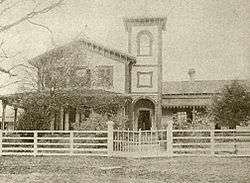Hawthorne (Prairieville, Alabama)
Hawthorne, also known as the Browder Place, is a historic Italianate plantation house and historic district in Prairieville, Alabama, USA. This area of Hale County was included in Marengo County before the creation of Hale in 1867.[2] Hawthorne is included in the Plantation Houses of the Alabama Canebrake and Their Associated Outbuildings Multiple Property Submission.[3] It was added to the National Register of Historic Places on July 7, 1994, due to its architectural significance.[1]
Hawthorne | |
 Hawthorne as it appeared in 1898 | |
  | |
| Nearest city | Prairieville, Alabama(Now Gallion) |
|---|---|
| Coordinates | 32°30′50″N 87°41′59″W |
| Built | 1818, renovated 1862 |
| Architect | Tayloe, J. W. |
| Architectural style | Italian Villa |
| MPS | Plantation Houses of the Alabama Canebrake and Their Associated Outbuildings Multiple Property Submission |
| NRHP reference No. | 94000694[1] |
| Added to NRHP | July 7, 1994 |
History
Construction on Hawthorne began in 1818. It was eventually enlarged to a large house with over 30 rooms and a full basement by the Manning family.[2] The property was later purchased by Dr. James Daniel Browder; by the end of the Civil War he had down sized most of the existing structure and completed the house as it stands today. The architect for Dr Browder's project was a young gentleman architect, Maj. J. W. Tayloe, of the Canebrake, perhaps the most notable young cotton planter in the area between 1850–60.[4] The eldest son of George Plater Tayloe of Buena Vista (Roanoke, Virginia) who owned considerable estates in the Arcola, Alabama neighborhood including "Elmwood" and brother to Col George E Tayloe, he was the grandson of Col. John Tayloe III of the Octagon House in Washington DC and great grandson of Col. John Tayloe II who built the grand colonial estate Mount Airy in Richmond Co Virginia. He graduated from Virginia Military Institute, inherited Walnut Grove Plantation and married Miss Lucie Randolph of "Oakleigh" plantation. He and the client designed the house with inspiration drawn from Samuel Sloan's 1852 publication of The Model Architect.[5]
Architecture
Hawthorne is built in the Italian Villa style. It comprises a main two-story block, a three-story tower, and an adjoining one-story wing. A one-story porch with corbel brackets wraps around the main block of the house. The gables and eaves on the main section and tower are also bracketed. Numerous French doors open onto the porch from the parlor and dining room. The tower contains an arched entrance vestibule at the base. It originally had arched windows on the third level, as well as decorative woodwork on the second level and around the ground floor archway. The tower windows have been replaced by simple square sash windows and the decorative details have been simplified with the addition of synthetic siding.[2]
References
- "National Register Information System". National Register of Historic Places. National Park Service. April 15, 2008.
- Marengo County Heritage Book Committee (2000). The heritage of Marengo County, Alabama. Clanton, Alabama: Heritage Publishing Consultants. pp. 20, 145, 146. ISBN 1-891647-58-X.
- Plantation Houses of the Alabama Canebrake and Their Associated Outbuildings MPS NRIS Database, National Register of Historic Places. Retrieved 6 March 2008.
- Chronicles of the Canebrake, John Witherspoon Dubose, Alabama Quarterly, Winter 1947
- Cooper, Chip; Harry J. Knopke; Robert S. Gamble (1993). Silent in the Land. Tuscaloosa, Alabama: CKM Press. pp. 144, 182. ISBN 0-9636713-0-8.